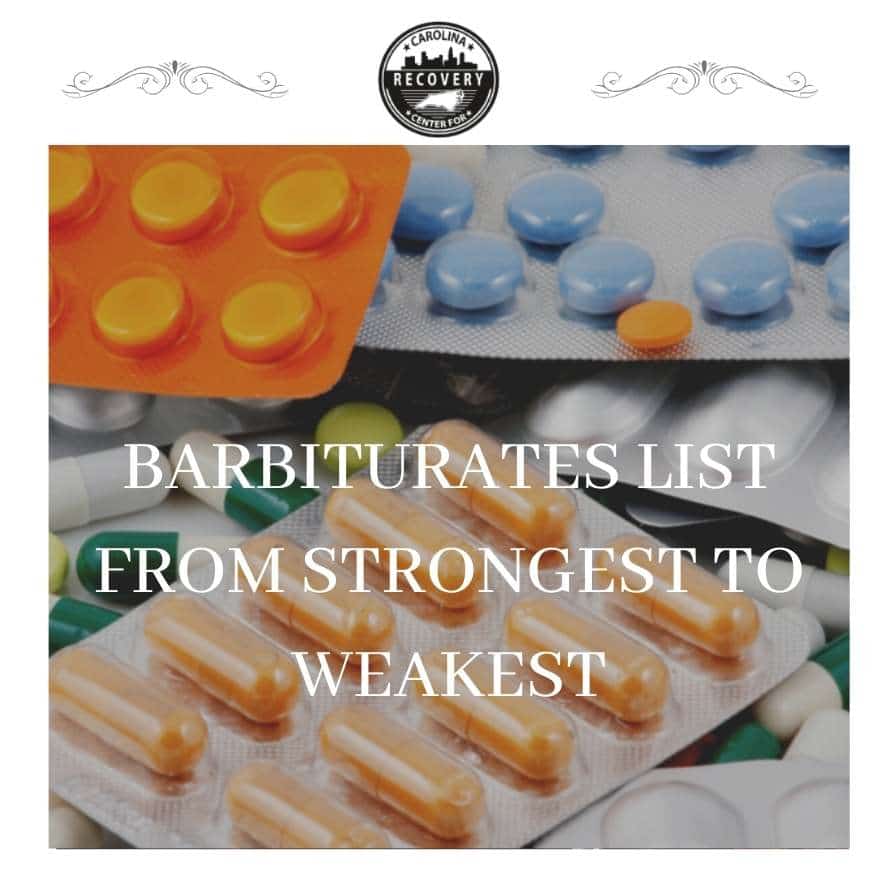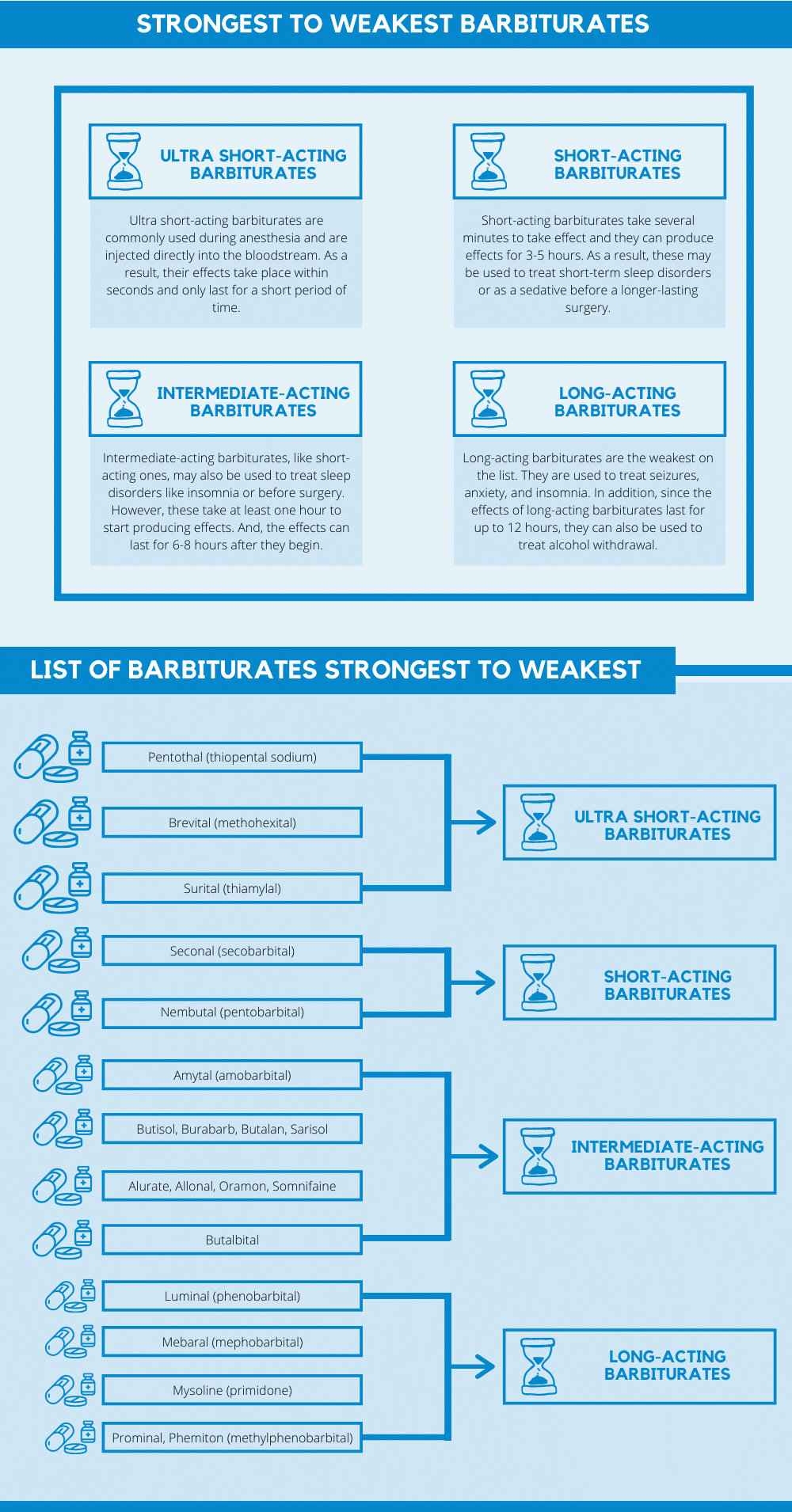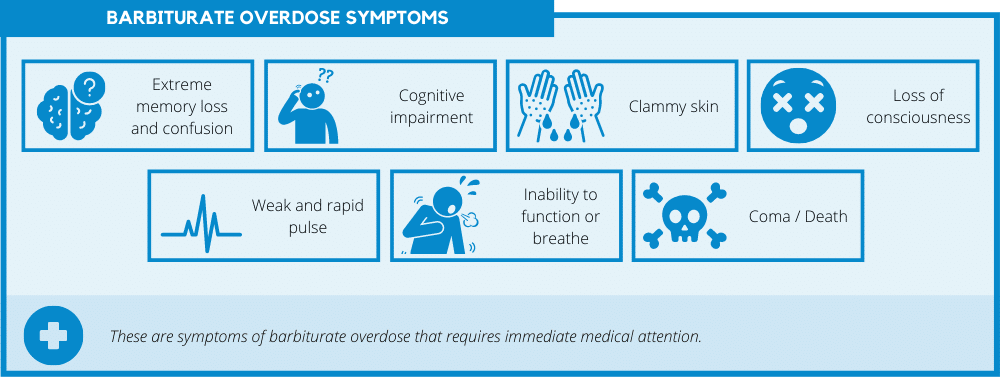Barbiturates List From Strongest to Weakest

Medically Verified: 2/1/24
Medical Reviewer
Chief Editor

All of the information on this page has been reviewed and verified by a certified addiction professional.
Some barbiturates are injected directly into the bloodstream while others take over an hour to produce any effects. Even though these drugs are rarely prescribed in medical settings today, they may still be abused illicitly on the streets. To better understand how these drugs work and why they are abused by drug users, let’s take a look at the list of barbiturates from strongest to weakest.
Understanding Barbiturates
Barbiturates were first synthesized in 1864 by Adolf von Baeyer, making possible the development of numerous sedative and hypnotic drugs.[1] Barbiturates are central nervous system depressants that relax the muscles and reduce feelings of anxiety. They also reduce heart rate, breathing, and blood pressure.[2]
Barbiturates work in a similar way as benzodiazepines as they affect gamma-aminobutyric acid (GABA), a neurotransmitter in the brain that regulates a host of vital body functions. In fact, barbiturates were the first line of treatment for seizures, insomnia, and anxiety between the 1920s and mid-1950s. These drugs were renowned for their sedative and hypnotic properties throughout the 60s and mid-70s.[1] Today, benzodiazepines are used more frequently instead.
Just like benzodiazepines, the ways in which barbiturates affect the brain are what make these drugs so addictive.
Barbiturate Street Names
Barbiturates are rarely used in the medical field anymore. Instead, many people who abuse them purchase the drugs illegally on the street.
When purchased illegally, barbiturates may be referred to as their street names or slang terms, like:[2]
- Barbs
- Sleepers
- Downers
- Phennies
- Blockbusters
Other barbiturate street names are unique to the type of barbiturate being sold. Here are some common street names associated with some of the most popular barbiturates:
- Phenobarbital – purple hearts, goofballs
- Pentobarbital – yellow jackets, Mexican yellows, nembies
- Secobarbital – pinks, pink ladies, reds, red devils, lilys
- Amobarbital – blue devils, blue velvet, blue heaven
List of Barbiturates Strongest to Weakest
There are over 50 different kinds of barbiturates on the market – and some are sold under multiple generic and brand names.[1]
In order to understand the list of barbiturates from strongest to weakest, it’s helpful to understand how the four different types of barbiturates affect the body and how long these effects last.

Ultra Short-Acting
Ultra short-acting barbiturates are commonly used during anesthesia and are injected directly into the bloodstream. As a result, their effects take place within seconds and only last for a short period of time. These drugs can make a person go unconscious for 5-25 minutes or more depending on the dose.
Being as strong and powerful as they are, ultra short-acting barbiturates are also used in assisted suicide and lethal injection. This is the strongest type of barbiturate on this list.
Examples of ultra short-acting barbiturates are:
- Pentothal (thiopental sodium)
- Brevital (methohexital)
- Surital (thiamylal)
Short-Acting
Short-acting barbiturates take several minutes to take effect and they can produce effects for 3-5 hours. As a result, these may be used to treat short-term sleep disorders or as a sedative before a longer-lasting surgery.
Short-acting barbiturates are weaker than ultra short-acting ones but stronger than intermediate ones.
Examples of short-acting barbiturates are:
- Seconal (secobarbital)
- Nembutal (pentobarbital)
Intermediate Acting
Intermediate-acting barbiturates, like short-acting ones, may also be used to treat sleep disorders like insomnia or before surgery. However, these take at least one hour to start producing effects. And, the effects can last for 6-8 hours after they begin.
Examples of intermediate-acting barbiturates are:
- Amytal (amobarbital)
- Butisol, Burabarb, Butalan, Sarisol (butabarbital)
- Alurate, Allonal, Oramon, Somnifaine (aprobarbital)
- Butalbital
Long-Acting
Long-acting barbiturates are the weakest on this list. They are used to treat seizures, anxiety, and insomnia. In addition, since the effects of long-acting barbiturates last for up to 12 hours, they can also be used to treat alcohol withdrawal.
Examples of long-acting barbiturates are:
- Luminal (phenobarbital)
- Mebaral (mephobarbital)
- Mysoline (primidone)
- Prominal, Phemiton (methylphenobarbital)
In summary, the list of barbiturates strongest to weakest is as follows:
- Ultra short-acting barbiturates
- Short-acting barbiturates
- Intermediate-acting barbiturates
- Long-acting barbiturates
Dangers of Barbiturate Abuse
Barbiturates suppress the central nervous system, slowing down brain function that affects various parts of the body including voluntary movements. As a result, high doses can severely affect a person’s automatic functions like heart rate and breathing.
Common side effects of barbiturate abuse include:[3]

- Impaired judgment
- Difficulty concentrating
- Slurred speech
- Decreased inhibitions
- Lack of coordination
- Vomiting
- Low blood pressure
- Slowed reflexes
- Sexual dysfunction
If a person takes too high of a dose, they could slow their heart rate and breathe so much to the point where they become unconscious and experience an overdose. Even the smallest dose increase can lead to poisoning and overdose.
Symptoms of barbiturate overdose that require immediate medical attention include:[3]

- Extreme memory loss and confusion
- Cognitive impairment
- Clammy skin
- Loss of consciousness
- Weak and rapid pulse
- Inability to function or breathe
- Coma and/or death
Furthermore, people who survive a barbiturate overdose may find themselves suffering from permanent kidney damage.
Help for Barbiturate Addiction
It doesn’t matter if someone is abusing the strongest barbiturate on this list or the weakest one, barbiturates of all strengths are addictive and dangerous when abused. Medically-assisted detoxification centers and inpatient treatment programs are equipped to help those struggling with addiction begin their journey towards recovery.
If you or someone you know is addicted to barbiturates, the time to ask for help is now. Call one of our dedicated treatment professionals today to turn your life around.
References:

